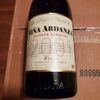2001 La Rioja Alta Rioja Viña Ardanza Reserva Especial
Community Tasting Note
campingfleurie wrote:
Friday, September 16, 2011 - Part 2 of my realisations this month about how wines breathe! Double-decanted, and first tasted at 10 mins. Subdued aroma of pale beef (lightly boiled beef), with a little pale-brown cherry and light earth. Initial texture is light-silk to powdered-earth - silk and silt! A gentle glycerine character - sweetness via syruph - but it's a lively syruph, and only a texturally flat, controlled one - we're not talking dramatic or blowsy Grenache-style. Rather coiled up acidity takes over. That spreads out in the finish, leaving a relatively searing impression! There's just a little roll of tannin. Overall the textural aspect of the finish is good - the mouth is faintly dried all-around (not just roof-mouth or gums), which speaks to me of balance and of coming into maturity. The mouth is satisfied all around. In the finish (20+ seconds in) the flavour deepens from pale, wet earth to a distinctly peaty character. That's good. At this stage the flavours and aromas are understated; which I do see as a valuable and natural characteristic of ageing; but I'd expect them to open out by meal time. Conversely, the acidity is strong, and I'd hope for that to calm. At meal time, 2.5 hours later, the wine had gained mahogany in the nose, and some strawberry and metal on the palate. The finish was a little looser than I was hoping for; containing rather limp cherry and rotting wood. This made me wonder whether it had had slightly too much air. It was much enjoyed, but I had some doubts. 89 pts then. A sample the next night showed a powerful, open, dramatic wine, with strong peaty, oily and musky flavours. There was flair and vertical scale in the mouth; and the whole was driven by still-potent acidity. Blood-orange and mineral inflections in the nose. It was better, and rather difficult to resist. 91-93 at that stage. I can confidently say that, to many tastes, there’re 10+ more years of accessibility here. The combination of this much acidity with (what was eventually revealed as) this much ripe-vintage concentration is exceptionally rare. I was lucky enough to drink a vertical of Lopez de Heredia Gran Reservas the other weekend, and this wine doesn’t fundamentally have the refinement, scale, or completeness of those (it’s closest to a Bosconia, if either.) However, this experience creates a craving to drink another bottle soon via a long-decant. The goal would be an experience in hard-core/macho, rustic grandeur (a hall of the mountain kings mouth sensation), completed with/by some really dark, burnt (not necessarily meaty) foodstuffs. Conclusion: high-acid, concentrated red wines breathe very slowly, so need long decanting even after reasonable ageing. I also sense that they have access to a compelling spectrum of flavours which can’t be reached by modern/low-acid wines. I hope that more growers start to see this light and take this direction! In order for drinkers not to find the flavours weedy, the grower would need to explain the ‘air per age’ regimen on the label.
Post a Comment / View campingfleurie's profile2 people found this helpful, do you? Yes - No / Report Issue (11,840 views)

